


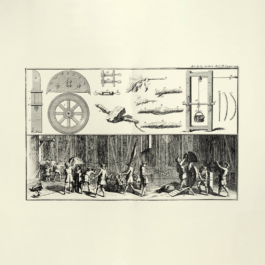
Illustration 1: The Art of Perfected Ropery
Research & production residency, 2022
⭢ Domaine de Boisbuchet & Rochefort, FR
An investigation into the Charente river estuary and its cultural and environmental features to create a performance with a group of creatives from diverse backgrounds
The time of climate crisis (but also of loss of sensitivity for other beings) that we are experiencing calls for the weaving of new relationships between humans and other-than-humans. Philosophers Donna Haraway and Vinciane Despret affirm that the creation of “anticipation tales” – stories mixing fiction and reality – can help build the foundations for these new relationships. Inspired by Haraway’s and Despret’s thoughts, we conceived COUNTERCURRENT, which we worked with a diverse group of international creatives employing design as an anticipation tool.
COUNTERCURRENT is conceived by d-o-t-s [Laura Drouet and Olivier Lacrouts] and organised in the frame of the Mondes Nouveaux, a grant programme financed by the French Ministry of Culture. Residency hosted by Boisbuchet.
Project team:
Pollyanna Moss, Evey Kwong [futurprimitiv], Dani Partnitzke, Wendy Owusu, Adrien Venath, Léone Salinas Muñiz, Jasmin Sisti
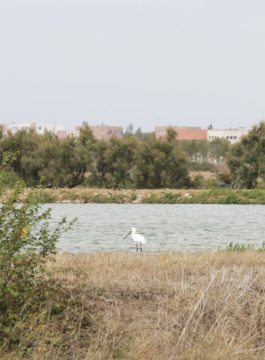
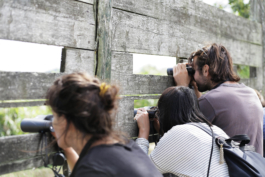
Learning from the Storks
•
The starting point of our investigations was the estuary of the Charente River, in the West of France, and the maritime city of Rochefort, which was for a long time the construction site of ships used by France for the subjugation of a distant and unknown “New World”. During the residency, we collectively deconstructed the ship – a tool of Euro-anthropocentric colonization – and built a series of devices that opened up possibilities for new connections with other animals that inhabit the Charente estuary: storks.
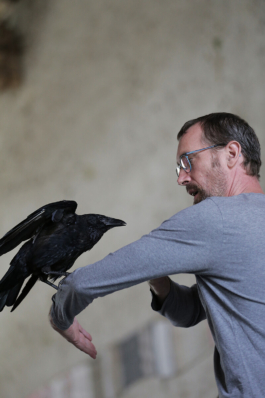
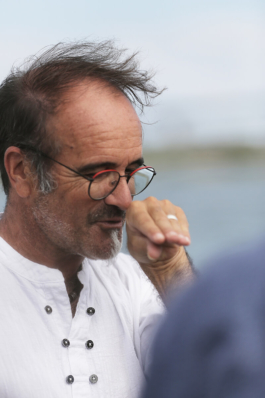
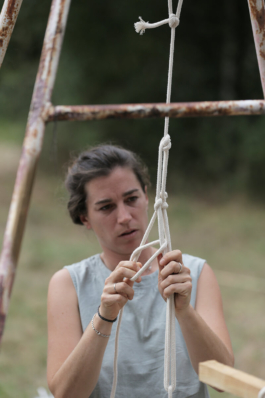
Tristan Plot (Specialist in gentle methods of bird training), Christophe Boucher (Bird protection specialist), Anne Lise Capelle (Maritime knotmaking specialist)
The Construction
•
Resembling the building of the Q’eswachaka rope bridge, a group contribution as a whole is more than the sum of its parts in braiding and pulling the ropes tight to create a sturdy structure.
In Southeast Asia, the embodied spirit can be experienced in “gotong-royong”, where the collective power of determination and collaboration becomes the force for communities. If one could experience a local event, “Angkat Rumah” (Carry a house) in real life, it can feel like a flashmob with every volunteer involved either taking turns to lift the house or joining the marching band to cheer with words of support and encouragement while the tonnes of a kampung house are moved from one place to another.
With COUNTERCURRENT, we enacted the spirit akin to these traditions. We created and built components of wooden ships, masts, and bird watching hides to create a public performance. The performance celebrates the interrelationship between humans and storks.
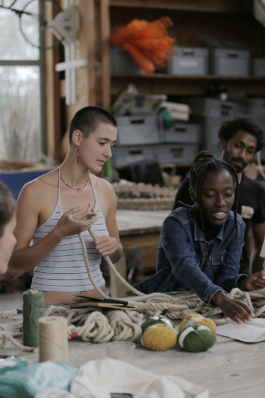
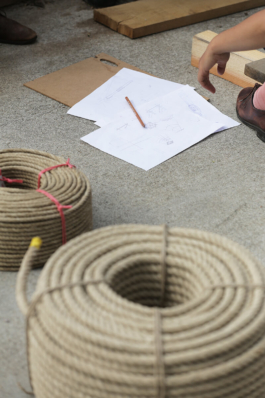
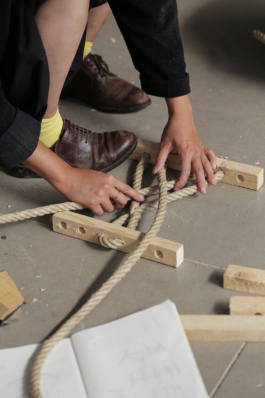
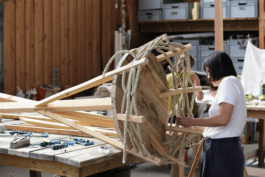
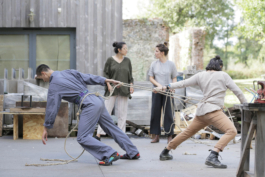
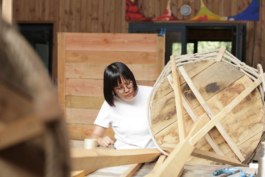
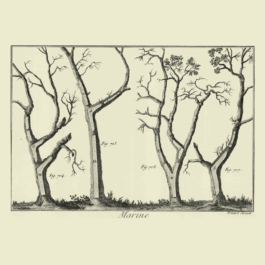
Illustration 2: Wooden elements were cut by making the best use of the natural curvature of the wood fibres. Louis Joseph Marie Achille Goujon, Des bois propres aux constructions navales, manuel à l'usage des agents forestiers et maritimes, 1807.
The Material
•
To symbolically deconstruct the vessel, we worked solely with materials traditionally used for the construction of sailing ships: locally sourced hemp ropes, linen textiles, and wood (oak* and pine).
The local material culture, landscapes, and histories helped to navigate and define our ideas to create the connection to the stork.
* Note: Oak wood is the one most commonly used for the construction of seagoing vessels: one absolutely cannot do without it; it is to be preferred to all the others, because it is harder, and more resistant to bad weather: moreover, it is very common, although it takes a long time to grow.

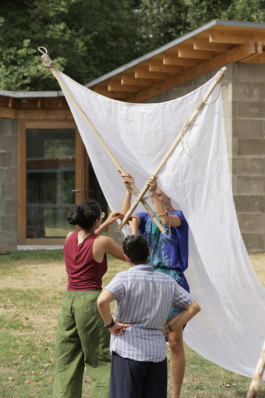
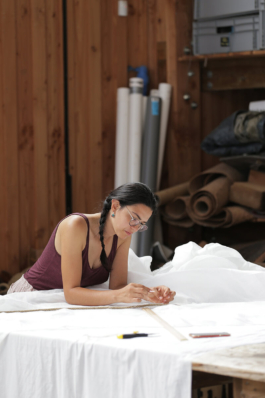
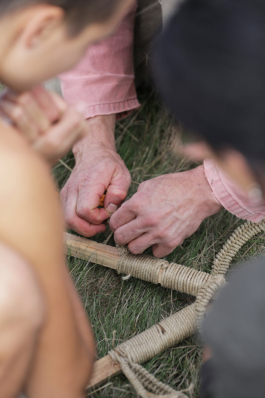

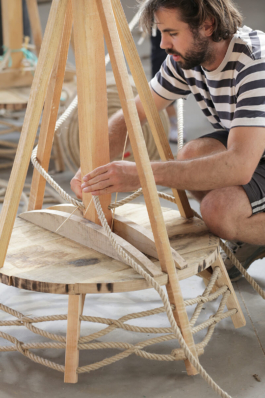
A performance to educate, play, and celebrate
•
A series of human-stork linking/encountering devices was enacted in a public performance*. During the performance, the locals of the Charente-Maritime came together to experience stories of the stork. We built nest structures, hides, a pulley system, lending the technologies from the maritime. The nest is a place where people gather: for shelter and to celebrate.
“White storks had all but disappeared from France 50 years ago, but today their numbers are increasing, particularly in the west of the country in departments such as Charente-Maritime. In 1974, there were only 11 stork couples left in France, nine of them in Alsace in the east of the country.
Today, Charente-Maritime has the greatest population of these large migrating birds, with around 636 couples and over 900 babies seen in 2020. Alsace used to have the most white storks, but today it is the area with the second-largest concentration in France.”¹
With COUNTERCURRENT, our hopes soar to send a message to the public on the importance of continuity to conserve nature and to help more storks settle in the marshes of Charente-Maritime.
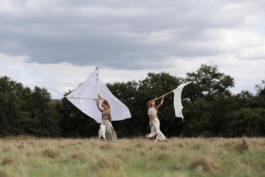
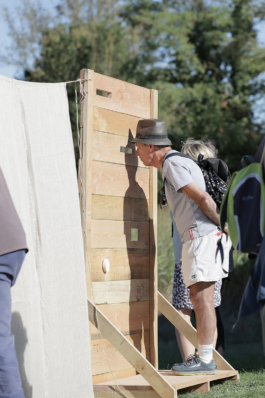
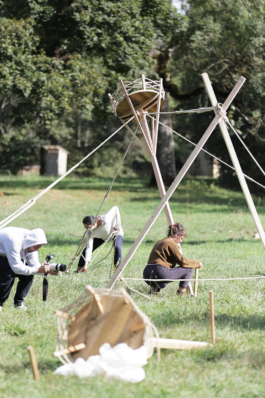
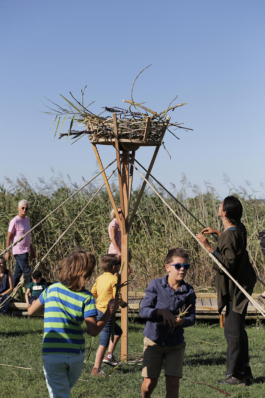
Photo credit:
[1] Illustration, «Traité de la fabrique des manœuvres pour les vaisseaux, ou L'Art de la Corderie perfectionné» de Duhamel Du Monceau Henry Louis. ©Copyright ANCRE - SOCIETE CIVILE
[2] Illustration, Wooden elements were cut by making the best use of the natural curvature of the wood fibres. Source: L'Encyclopédie méthodique de la Marine, 1807
All images by Olly Cruise and Laura Drouet
Bibliography:
[1] Facts extracted from the Connexion

Illustration 1: The Art of Perfected Ropery
Research & production residency, 2022
⭢ Domaine de Boisbuchet & Rochefort, FR
An investigation into the Charente river estuary and its cultural and environmental features to create a performance with a group of creatives from diverse backgrounds
The time of climate crisis (but also of loss of sensitivity for other beings) that we are experiencing calls for the weaving of new relationships between humans and other-than-humans. Philosophers Donna Haraway and Vinciane Despret affirm that the creation of “anticipation tales” – stories mixing fiction and reality – can help build the foundations for these new relationships. Inspired by Haraway’s and Despret’s thoughts, we conceived COUNTERCURRENT, which we worked with a diverse group of international creatives employing design as an anticipation tool.
COUNTERCURRENT is conceived by d-o-t-s [Laura Drouet and Olivier Lacrouts] and organised in the frame of Mondes Nouveaux, a grant programme financed by the French Ministry of Culture. Residency hosted by Boisbuchet.
Project team:
Pollyanna Moss, Evey Kwong [futurprimitiv], Dani Partnitzke, Wendy Owusu, Adrien Venath, Léone Salinas Muñiz, Jasmin Sisti


Learning from the Storks
•
The starting point of our investigations was the estuary of the Charente River, in the West of France, and the maritime city of Rochefort, which was for a long time the construction site of ships used by France for the subjugation of a distant and unknown “New World”. During the residency, we collectively deconstructed the ship – a tool of Euro-anthropocentric colonization – and built a series of devices that opened up possibilities for new connections with other animals that inhabit the Charente estuary: storks.



Tristan Plot (Specialist in gentle methods of bird training), Christophe Boucher (Bird protection specialist), Anne Lise Capelle (Maritime knotmaking specialist)
The Construction
•
Resembling the building of the Q’eswachaka rope bridge, a group contribution as a whole is more than the sum of its parts in braiding and pulling the ropes tight to create a sturdy structure.
In Southeast Asia, the embodied spirit can be experienced in “gotong-royong”, where the collective power of determination and collaboration becomes the force for communities. If one could experience a local event, “Angkat Rumah” (Carry a house) in real life, it can feel like a flashmob with every volunteer involved either taking turns to lift the house or joining the marching band to cheer with words of support and encouragement while the tonnes of a kampung house are moved from one place to another.
With COUNTERCURRENT, we enacted the spirit akin to these traditions. We created and built components of wooden ships, masts, and bird-watching hides to create a public performance. The performance celebrates the interrelationship between humans and storks.



Conceptual stage






Production stage

Illustration 2: Wooden elements were cut by making the best use of the natural curvature of the wood fibres. Louis Joseph Marie Achille Goujon, Des bois propres aux constructions navales, manuel à l'usage des agents forestiers et maritimes, 1807.
The Material
•
To symbolically deconstruct the vessel, we worked solely with materials traditionally used for the construction of sailing ships: locally sourced hemp ropes, linen textiles, and wood (oak* and pine).
The local material culture, landscapes, and histories helped to navigate and define our ideas to create the connection to the stork.
* Note: Oak wood is the one most commonly used for the construction of seagoing vessels: one absolutely cannot do without it; it is to be preferred to all the others, because it is harder, and more resistant to bad weather: moreover, it is very common, although it takes a long time to grow.



A performance to educate, play, and celebrate
•
A series of human-stork linking/encountering devices was enacted in a public performance*. During the performance, the locals of the Charente-Maritime came together to experience stories of the stork. We built nest structures, hides, a pulley system, lending the technology from the maritime. The nest is a place where people gather: for shelter and to celebrate.
“White storks had all but disappeared from France 50 years ago, but today their numbers are increasing, particularly in the west of the country in departments such as Charente-Maritime. In 1974, there were only 11 stork couples left in France, nine of them in Alsace in the east of the country.
Today, Charente-Maritime has the greatest population of these large migrating birds, with around 636 couples and over 900 babies seen in 2020. Alsace used to have the most white storks, but today it is the area with the second-largest concentration in France.”¹
With COUNTERCURRENT, our hopes soar to send a message to the public on the importance of continuity to conserve nature and to help more storks to settle in the marshes of Charente-Maritime.




Many thanks:
Production support by Agence Eva Albarran. Partners: Conservatoire du littoral and LPO France, with the participation of Anne Lise Capelle, Tristan Plot, Christophe Boucher, and Nicolas Gendre (LPO Charente Maritime).
Photo credits
[1] Illustration, “Traité de la fabrique des manoeuvres pour les vaisseaux, ou L'Art de la Corderie perfectionné” by Duhamel Du Monceau Henry Louis. ©Copyright ANCRE - SOCIETE CIVILE
[2] Illustration, Wooden elements were cut by making the best use of the natural curvature of the wood fibres. Source: L'Encyclopédie méthodique de la Marine, 1807
All images by Olly Cruise and Laura Drouet
Bibliography:
[1] Facts extracted from the Connexion